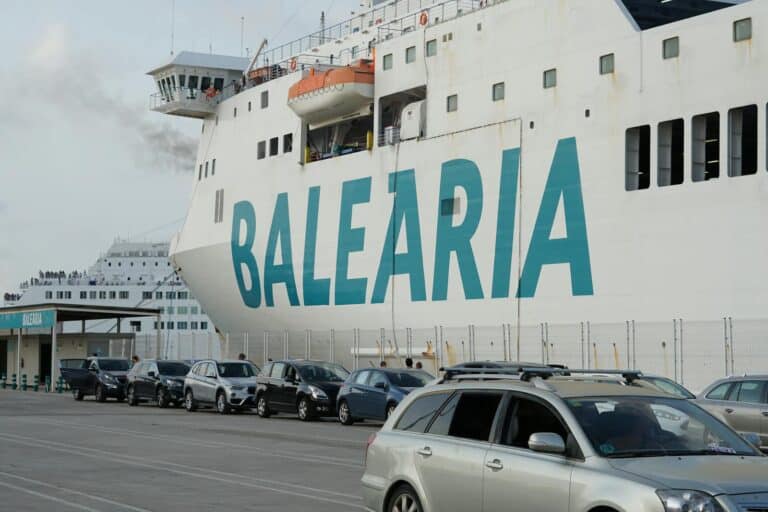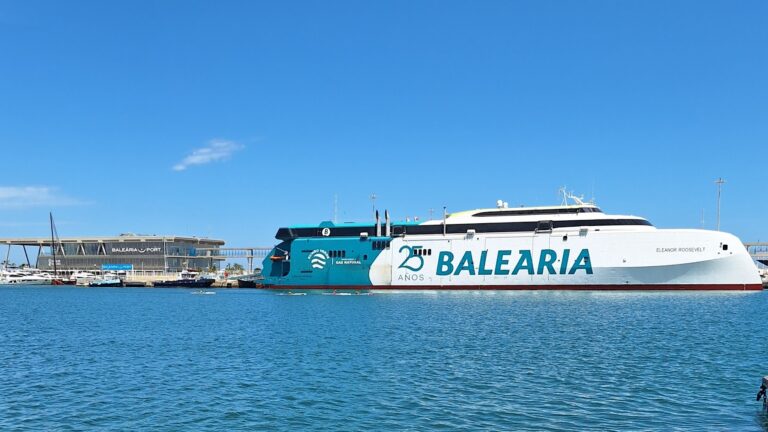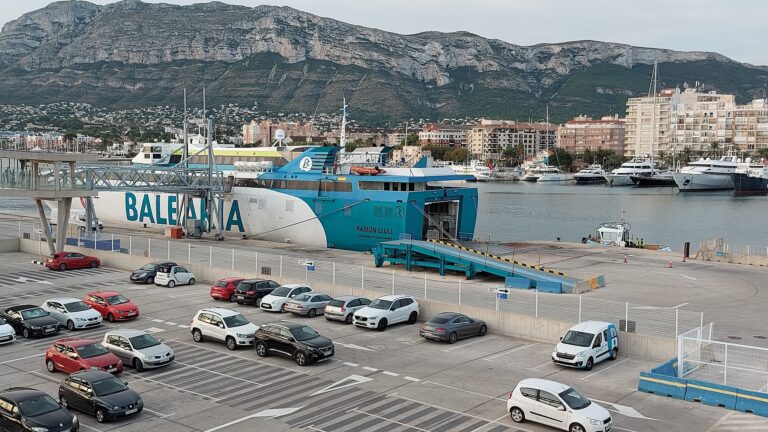Ferry Denia – Ibiza: Complete Guide for Independent Travelers
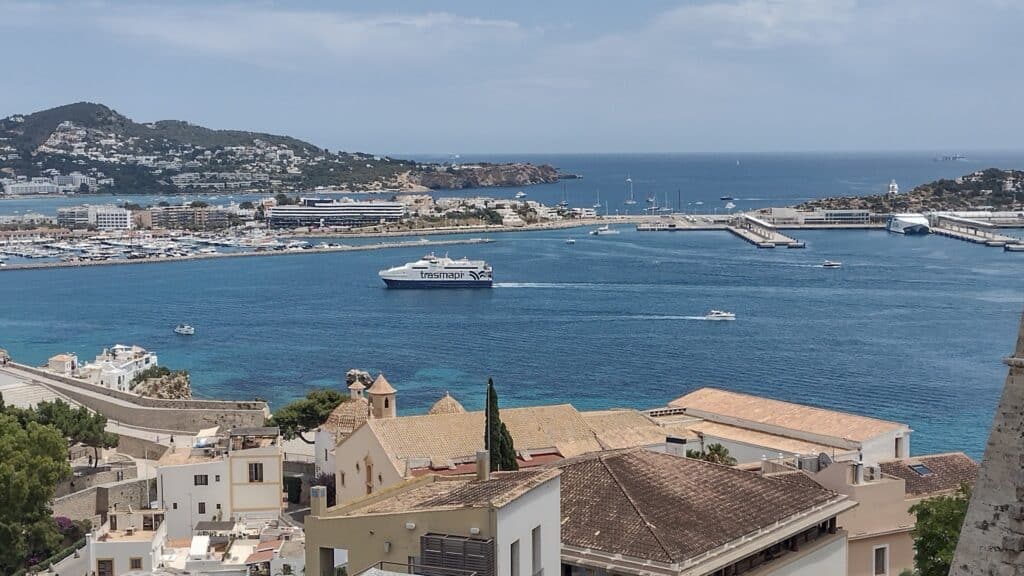
The snow-white Denia – Ibiza ferry cuts through the azure waves of the Mediterranean Sea. The sun plays with reflections on the water. After three hours of sailing, the legendary island welcomes its guests. I didn’t choose this sea route by chance. After a dozen flights, I realized that a ferry crossing offers something you can’t get on a plane.
The port of Denia is located just an hour’s drive from Alicante airport. Ferries run every day, even in the low season. Companies Balearia and Trasmediterranea offer different types of vessels and comfort classes. You can buy a ticket in advance online or directly at the port.
Unlike on a plane, there are no baggage restrictions on the ferry. You can bring a whole suitcase of diving equipment if you want. Or bring home all the souvenirs you desire. And you don’t need to arrive two hours before departure and stand in endless security queues.
There are restaurants and bars on board. You can walk on the deck and breathe in the sea air. In good weather, you can see dolphins – they often accompany the ship. Children are thrilled by this adventure.
The ferry schedule is very convenient. There are morning and evening sailings. I usually choose the morning one – I manage to arrive in Ibiza by lunchtime and check into the hotel right away.
The ticket price depends on the season and service class. Prices are higher in summer, especially in August. However, in winter you can find tickets with discounts of up to 40%. The basic class includes a seat in the lounge. For an extra charge, cabins are available – a great option for an overnight trip.
Denia-Ibiza ferry schedule for 2025 (carriers Balearia and Trasmed GLE)
| Period | Company | Departure | Arrival | Duration |
|---|---|---|---|---|
| January-March | Balearia | 17:00 | 19:15 | 2h 15min |
| April | Balearia | 08:30 | 11:45 | 3h 15min |
| Balearia | 17:00 | 19:15 | 2h 15min | |
| Trasmed GLE | 22:31 | 05:15 | 6h 44min | |
| May-June | Balearia | 08:30 | 10:45 | 2h 15min |
| Balearia | 17:00 | 19:15 | 2h 15min | |
| July-August | Balearia | 08:30 | 10:45 | 2h 15min |
| Balearia | 17:00 | 19:15 | 2h 15min | |
| Balearia | 22:00 | 00:30 | 2h 30min | |
| Trasmed GLE | 22:31 | 05:15 | 6h 44min | |
| September-October | Balearia | 08:30 | 10:45 | 2h 15min |
| Balearia | 17:00 | 19:15 | 2h 15min | |
| November-December | Balearia | 17:00 | 19:15 | 2h 15min |
Schedule notes:
- Trasmed GLE:
- Operated by the Ciudad de Mahón vessel with a stop in Formentera.
- 3-4 sailings per week (April-August), daily in July-August.
- Balearia journey durations:
- Increased travel time in April due to a technical stop.
- Night sailing (22:00) in July-August offers cabin services.
- Seasonal changes:
- Trasmed GLE doesn’t operate from January to March.
- Morning Balearia sailings available from April to October.
Price dynamics (starting fares):
| Company | Passenger ticket | Vehicle |
|---|---|---|
| Balearia | 40–85€ | +35–80€ |
| Trasmed GLE | 55–110€ | +50–100€ |
For current schedules and bookings, use:
🔗 Balearia official website
🔗 Trasmed GLE portal
It’s best to book tickets 2-3 months before your trip, especially if you’re planning to travel during the high season from June to September. The carriers’ websites have a price calendar – convenient for selecting optimal dates.
The main advice – check the weather forecast. In stormy conditions, the rolling can be significant. Although modern ferries are equipped with stabilizers, seasickness can ruin your trip.
Why is the ferry the best way to get to Ibiza from Denia?
I recently compared the cost of the Denia – Ibiza ferry crossing with the average price of airline tickets. The difference was impressive. A ferry ticket in summer costs from 50 to 80 euros one way. For this money, you get a full-fledged sea journey with a seat in the lounge. An air flight during the same period will cost at least 120-150 euros. And if you buy tickets a week before the trip, the price skyrockets.
With a car, the story is even more interesting. Balearia charges about 100 euros for transporting a car on the ferry. Renting the same car in Ibiza will cost 60-70 euros per day. For a week’s vacation, the savings will be more than 300 euros.
The seats in the lounge are equipped with reclining armchairs with armrests. Sockets for charging gadgets are built right into the seats. Wi-Fi works throughout the ferry.
The air conditioning system maintains a comfortable temperature. Unlike on a plane, here you can move freely around the decks. Bars and restaurants offer Mediterranean cuisine at reasonable prices. A cup of coffee costs 2.5 euros – the same as in a regular city cafe.
There’s an observation deck on the upper deck. From here I watched dolphins and the sunset. Such moments can’t be bought for any money.
You can load any land vehicle onto the ferry. Bicycles are transported for free. A motorcycle will cost 30-40 euros. With a car, the procedure is extremely simple. You arrive at the terminal an hour before departure. Show your documents. Park in the hold following the signs. The whole process takes 15 minutes.
There are practically no baggage restrictions. I easily transported four large suitcases and boxes with electronics. No one weighed the items or demanded additional payment.
How to book tickets for the Denia – Ibiza ferry?
Over the past three years, ferry booking services have become extremely convenient. Direct Ferries has opened a Russian-language interface with support for ruble payments. Ferryhopper has added a mobile app with push notifications about flight status. On both sites, tickets for the Denia – Ibiza ferry are available 6 months before departure. The search system automatically shows all options – from budget seats in the lounge to luxurious cabins with windows.
Through Direct Ferries, I bought tickets with a 30% discount. The secret is that prices change every day. The site uses dynamic pricing like airlines. Tuesday and Wednesday are the most profitable days to buy. And if you set flexible travel dates, the system will find the minimum fare within a range of plus or minus 3 days.
The basic ticket provides a seat in the economy class lounge. The standard fare includes access to the business lounge with free coffee. VIP class offers a private cabin and restaurant menu.
Ferryhopper has introduced a storm insurance option. If the trip is canceled due to weather conditions, the carrier will refund the full cost of the ticket. Or offer an alternative date at no extra charge. The cost of insurance is 5 euros per person.
For online check-in, a passport is sufficient. The boarding pass arrives by email 24 hours before departure. There’s a separate counter for passengers with electronic tickets at the port of Denia. No queues or paperwork.
Each carrier has its own loyalty program. Balearia awards points for each trip. They can be exchanged for a free ticket or service class upgrade. Trasmediterranea gives a 10% discount on the next booking. Some bank cards add cashback of up to 5% when paying for sea transportation.
A price calendar helps track promotions. Dates with discounts are highlighted in yellow. High demand days are in red. If there are no strict date constraints, it’s better to plan your trip for mid-week. On weekends, tickets are on average 20 euros more expensive.
Denia – Ibiza ferry schedule

Ferries from the port of Denia depart for Ibiza on a dynamic schedule. In summer, I counted six daily trips – three fast and three regular. In October, Balearia reduces the schedule to four departures. In winter, only two trips per day remain. Every year, carriers make changes to the schedule based on demand and weather conditions.
The high-speed ferry covers the route in 2 hours. The standard vessel takes 4 hours. I’ve tested both options. The price difference is 20 euros. For the extra cost, you get not only time savings but also a more comfortable cabin with panoramic windows.
The earliest departure is at 7:30 AM. Perfect for those who want to spend a full day on the island. At sunset, the ferry transforms into a romantic venue. The last departure at 10:30 PM is my favorite trip. You fall asleep to the sound of waves and wake up already on Ibiza.
High-speed vessels may be canceled during storms. I encountered this in November. The carrier offered a spot on the standard ferry or rescheduling for the next day. Now I always check the weather forecast a week before the trip.
Morning trips are usually 60% full. Evening ones are packed. On Fridays and Sundays, tickets sell out a month in advance. The Balearia website has a counter for available seats. Numbers are updated in real-time.
There’s an unspoken hierarchy between trips. The 11 AM ferry has more retirees and families with children. Evening trips are favored by young people. At 3:30 PM, it’s mostly locals traveling. They know there are fewer tourists at this time and it’s easier to find a window seat.
The schedule is synchronized with bus timetables from Alicante. The transfer arrives 40 minutes before each ferry departure. The connection is precise – the ferry won’t leave without passengers from the bus.
In December, ferries run less frequently, but tickets cost half as much. Plus, the winter schedule is stable – no weather-related cancellations.
What to expect on board the ferry?
On the spacious deck of the Denia – Ibiza ferry, a whole floating city unfolds. In the central hall, a chrome bar counter gleams. Behind it are duty-free shop windows with perfumes and alcohol. On the upper deck, there’s a restaurant with panoramic windows. From here, you can watch seagulls and dolphins. On a clear day, the horizon merges with the sky into a single blue line.
The bar serves excellent coffee. A double espresso is 3 euros. A ham sandwich is 5 euros. Prices are the same as in a regular cafe onshore. You can pay by card or cash.
In economy class, seats are arranged like on an airplane. But the chairs are wider and recline more. Each passenger has their own power outlet and cup holder. Wi-Fi works on all decks. The speed is sufficient for watching YouTube and chatting on messenger apps.
The standard class impressed with leather seats and access to the business lounge. There’s a coffee machine, snacks, and fresh press there. VIP cabins are equipped with a shower and mini-bar. Ideal for overnight crossings.
Pets are transported in special boxes on the lower deck. There are kennels with water bowls for dogs. Cats travel in carriers. Once an hour, owners are allowed to check on their pets.
The cost of transportation depends on the size of the animal. A small dog or cat is 15 euros. A large dog is 25 euros. A veterinary passport with vaccination records is required.
In economy class, you can save on food. I bring a thermos with coffee and sandwiches. No one checks hand luggage at the entrance. The main thing is not to have a picnic in the cabin.
Not all seats have power outlets. Seats with connections are marked with a special icon on the cabin layout. Choose them first when checking in online.
How to get to the port of Denia?
I’ve gotten to the port of Denia in different ways. The easiest route is by car following the signs for Port de Dénia. The navigator will lead you to the ferry terminal in 10 minutes from the city center. At the port entrance, there’s a covered parking lot for 400 cars. The first two hours cost 2 euros, then 1 euro per hour. For long-term parking, it’s better to leave your car at the free La Panseta parking lot, a five-minute walk away.
Public transport is also reliable. Bus L2 runs every 30 minutes from the train station. The stop is right at the terminal – Port Dénia. A ticket costs 1.5 euros. During the season, they additionally launch route L5 from the tourist area of Las Rotas.
A taxi from the center of Denia to the port will cost 7-8 euros. Drivers know the ferry schedule and adapt to it. I often order a car through the PideTaxi app – it’s a euro cheaper than hailing one on the street.
From May to October, a free shuttle boat La Panseta runs between Les Marines beach and the port. It’s a great alternative for those staying in hotels on the coast. The trip takes 15 minutes, and the views of the bay are stunning.
For walking enthusiasts, there’s the Paseo Marítimo promenade. It’s a 25-minute leisurely walk from the historic center to the port. Along the way, you’ll find cozy cafes with views of the yachts. The route is marked with blue Port signs.
At the terminal entrance, there’s a tourist office. They provide free port maps and La Panseta boat schedules. On the ground floor, there are lockers – 4 euros for a locker for the whole day. There’s also an ATM and a pharmacy nearby.
A Mercadona supermarket is open in the terminal building. Before the trip, you can buy water and snacks at regular city prices, instead of overpaying later on the ferry. The store is open until the last evening ferry.
What to see in Ibiza?
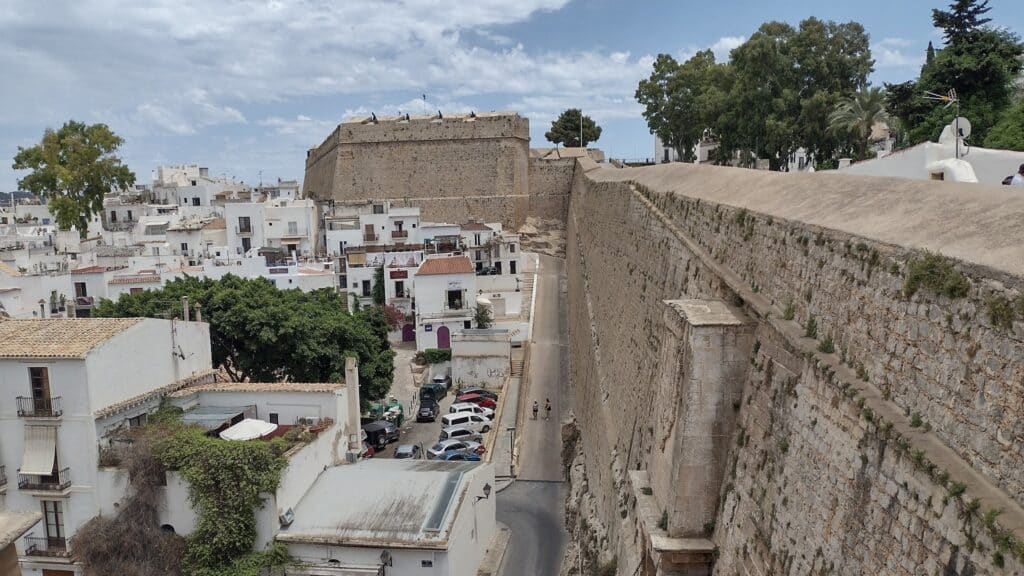
The ferry from Denia docks right at the foot of the old town, Dalt Vila. The snow-white 16th-century fortress walls tower over the port like a historical film set. UNESCO has included this architectural complex in the World Heritage List. I wander through narrow streets between stone houses. Each door here holds its own history. At the top of the hill, there’s a viewing platform with a panorama of the entire island.
After the historical part, I’m drawn to Ibiza’s famous beaches. Playa d’en Bossa stretches for two kilometers along the coast. The fine white sand resembles powdered sugar. The water is clear even during storms. An umbrella and lounger will cost 20 euros for the whole day.
I rent a car right at the port. Local rental agencies offer cars from 35 euros per day. You can leave a deposit with a card. I get behind the wheel immediately after showing my passport and driver’s license.
First, I drive to Ses Salines beach. The road winds between salt flats. Pink flamingos wade in shallow water. The photos turn out like National Geographic postcards. The beach is only a 15-minute drive from the port.
At sunset, I head to Cala Comte bay. The rocky shore drops off into the sea. The water shimmers in all shades of turquoise. Local fishermen prepare fresh paella right on the beach. The aroma of spices mixes with the salty breeze.
Amnesia club opens at midnight. The best DJs on the planet come here. The two-story space accommodates five thousand people. Tickets start at 40 euros. In the VIP area, you can meet Hollywood stars and Real Madrid footballers.
Pacha has been operating on the island since 1973. This club set the trend for elegant luxury casual parties. The dress code is strict – no flip-flops or shorts. Music plays until dawn.
From Ibiza, you can sail to Formentera island in 30 minutes. Ferries run every hour from seven in the morning. The last ferry departs at eleven in the evening. A round-trip ticket will cost 30 euros.
Formentera has the most beautiful beaches in the Mediterranean. The water is so clear that you can see the bottom at a depth of ten meters. The temperature doesn’t drop below 20 degrees even in winter.
Useful tips for traveling on the Denia – Ibiza ferry
I arrive at the Denia – Ibiza ferry an hour before departure. This is an inviolable rule for me. Last year, I watched a late couple desperately trying to get on board 15 minutes before departure. Neither pleas nor tears helped – the port security service was adamant. And the tickets were bought on sale for half price. Now I plan my time with a buffer and calmly go through all the formalities.
Customs control in the port of Denia is quick. It’s enough to show your passport and ticket. But with a car, the procedure takes more time. They check car documents, insurance, and inspect the trunk. Sometimes during high season, the queue of cars stretches for half an hour.
There’s always a strong wind on the upper deck. Even in July heat, I bring a windbreaker or light sweater. The air conditioning in the lounge works at full power. Without warm clothes, you risk freezing.
The motion on the Denia – Ibiza ferry can be noticeable. Special anti-seasickness wristbands are sold at the port pharmacy. They’re inexpensive – 5 euros for a pair. They work effectively. Just in case, I keep mint lozenges in my pocket. They help deal with mild nausea.
Suitcase size doesn’t matter. The ferry isn’t a plane, there are no strict weight restrictions here. I easily bring four large bags and a backpack. The main thing is to pack things compactly in the luggage compartment.
The rules are stricter for animals. Dogs must wear muzzles. Cats must be in carriers. They always check the pet passport. Last month, I saw tourists turned away because their puppy didn’t have a rabies vaccination.
The power outlets on the ferry are European standard. My universal adapter turned out to be useless. Now I bring a regular charger with me. Wi-Fi is unstable. I make sure to download movies and books to my phone in advance.
The onboard café accepts cards and euros. The exchange rate at the port is unfavorable. It’s better to exchange money in the city or withdraw cash from an ATM. There are only two ATMs at the dock, and they charge exorbitant withdrawal fees.

